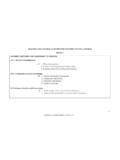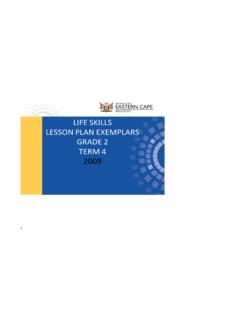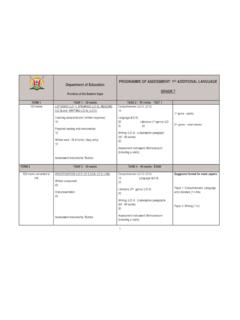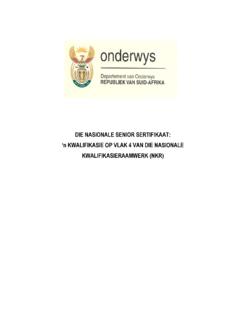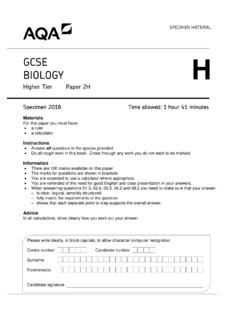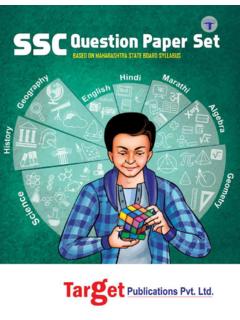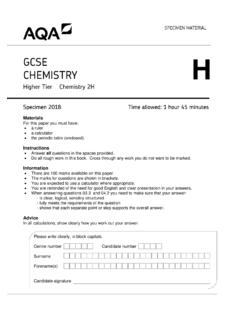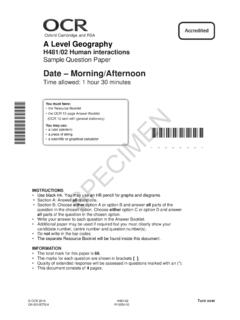Transcription of Grade 12 Mathematical Literacy: Question Paper 2 …
1 Mathematical literacy (NCS)/ Grade 12/P2 72 ExemplarGrade 12 Mathematical literacy : Question Paper 2 MARKS: 150 TIME: 3 hours Question 1In January 2006 Luka (36 years old) worked for a hotel chain. Luka s gross annual salary was R97 575,00. the extract from the SARS tax table to determine how much tax (SITE + PAYE) Luka paid in 2006 (3) employees contribute 1% of their monthly salary to the Unemployment Insurance Fund (UIF), how much did Luka contribute to UIF each month in 2006? (4) , or otherwise, show that Luka s take-home salary was R7 009,51 (3)Copyright reserved Please turn overMathematical literacy (NCS)/ Grade 12/P2 73 ExemplarAccording to market researchers, people in Luka s income bracket typically spend their money as shown in the pie chart below.
2 Top 10 items of expenditure for the "emerging middle class"Food26,5%Clothing, footwear & accessories5,0%Housing & electricity18,9%Insurance & funds6,5%Personal care3,7%Communication3,7%Savings4,3%Othe r17,6%M edical & dental4,0%Transport9,7% that Luka s money is spent as shown in the graph and calculate to the nearest Rand how much of each month s take-home salary is spent on the following:yFoodyClothing, footwear and accessories yHousing and electricity yTransport(8) to the table below which lists the change in CPI for each of the expenditure groups listed in the pie chart from 2006 to 2007. By referring to you answers to , determine the missing values a to e in the table (you need only write down the values and show your calculations).
3 (10)Expenditure group Typical monthly spend by Luka in January 2006 Percentage change in CPI for expenditure group Anticipated monthly spend by Luka in January 2007 see answer Food 9,3% asee answer Clothing, footwear & accessories -10,9% bsee answer Housing & electricity 9,2% csee answer Transport6,8% dR280,00 R296,00 M edical & dental 5,6% R456,00 R480,00 Insurance & funds R259,00 R272,00 Personal care 5,0% R259,00 R260,00 Communication 0,2% R301,00 R395,00 Savings R1 234,00 R1 319,00 Other 6,9% R7 003,00 eCopyright reserved Please turn overMathematical literacy (NCS)/ Grade 12/P2 74 the percentage change in total expenses for Luka from 2006 to 2007.
4 (4) s employer offers Luka an inflation-linked salary increase of 5% for hat would Luka s gross salary be after this increase? (3) tax formula applicable to 2007 is shown below. Use this formula and the salary you calculated in to show that Luka s monthly take home salary after paying tax and UIF contributions will be R7 501,31. (7)Rates applicable to individuals TAXABLE INCOM ERATES OF TAXRRRR0 100 000 18%of each R1 100 001 160 000 18 000+25%of the amount above 100 000160 001 200 000 33 000+30%of the amount above 160 000220 001 300 000 51 000+35%of the amount above 200 000300 001 400 000 79 000+38%of the amount above 300 000400 001 and above 117 000+40%of the amount above 400 000 Tax Rebates R7 200 x Primary rebate.
5 R4 500 x Additional rebate (for person 65 years and older) . the percentage increase in take-home salary from January 2006 to January 2007 and explain in terms of tax rates why this is greater than the 5% increase that the employer gave Luka. (8) referring to Luka s anticipated expenses ( Question ) determine whether Luka will be able to maintain the lifestyle of January 2006 in January 2007 justify your answer. (3)[53]Copyright reserved Please turn overMathematical literacy (NCS)/ Grade 12/P2 75 ExemplarQUESTION 2 The graph below compares the effective income tax rate applicable to South Africans from the 2005 to 2008 tax years. Effective income tax rates 2005 to 2008 (South Africa)0%5%10%15%20%25%30%35%40%R0R50 000R100 000R150 000R200 000R250 000R300 000R350 000R400 000R450 000R500 000R550 000R600 000R650 000R700 000R750 000R800 000R850 000R900 000R950 000R1 000 000 Annual incomeEffective tax was the effective tax rate paid by a person earning R150 000 in each of the years 2005; 2006; 2007 and 2008?
6 (4) much would a person have to earn to pay an effective tax rate of 25% in each of the years 2005; 2006; 2007 and 2008? (4) much would a person earning R100 000 in 2008 have paid in income tax? (2) the trend in effective income tax rate over the period 2005 to 2008 motivate your answer. (4)[14]Copyright reserved Please turn overMathematical literacy (NCS)/ Grade 12/P2 76 ExemplarQUESTION in your own words what is meant by the following: the student taking the test scored at the 75th percentile (2) results for a particular test are summarised alongside. In which quartile would a person with a total of 88 fall? Test ScoresFrequency66 - 70 471 - 75 376 - 80 281 - 85 686 - 90 391 - 95 2(2)Questions and on the next page refer to the graph below.
7 BMIBMI85909597755025103 Copyright reserved Please turn overMathematical literacy (NCS)/ Grade 12/P2 77 Mass Index (BMI) is a number calculated from a child s weight and height. BMI number is plotted on the CDC BMI-for-age growth charts (for either girls or boys) to obtain a percentile ranking. BMI-for-age weight status categories and the corresponding percentiles are shown in the following table. Weight Status Category Percentile Range thUnderweightLess that the 5 percentile Healthy weight 5th percentile to less than the 85th percentile thAt risk of overweight 85 to less that the 95th percentile thOverweightEqual to or greater that the 95 percentile what percentile would an 8 year old boy with a BMI of 17 be?
8 (2) is the BMI of a 5 year old boy if his BMI places him at the 90thpercentile? (2) what range can a 10 year old boy s BMI be if his weight is to be considered healthy ? (4) 2weight (kg)BMI = height (m)BMI is calculated using the formula is the weight status of an 8 year old boy who is 120cm tall and who weighs 30kg? (5) heavy would a 16 year old boy be if he is 1,65m tall and his BMI is at the 50th percentile? (5)[22]Copyright reserved Please turn overMathematical literacy (NCS)/ Grade 12/P2 78 ExemplarQUESTION 4 Arrive Alive ( ) publishes a large number of statistics related to fatalities (deaths) as a result of motor car accidents. The questions that follow are based on the information supplied in the tables and graphs fatalities on the South African Roads have been reported in terms of both the actual number of fatalities and as a rate: the number of fatalities per 100 000 people in the the graph that reports the percentage of fatalities per time of day fraction of all fatalities occurs between 17h00 and 22h00?
9 (4) do you think there is a sharp rise in the graph around 08h00? (3) what times of day are you at greatest risk of being killed in a motor vehicle related accident? Substantiate your claim (4)Fatalities on South African Roads 1990 to 2004020004000600080001000012000140001990 1991 1992 1993 1994 1995 1996 1997 1998 1999 2000 2001 2002 2003 2004 YearNumber of fatalities0510152025303540 Fatalities per 100 000 people Number of fatalitiesFatalities p er 100 000 Percentage of fatalities per time of day0%2%4%6%8%10%12%123456789 10 11 12 13 14 15 16 17 18 19 20 21 22 23 24 Time of day (hours)Fatalities on South African Roads 1990 to 2004 umber of road fatalitiesSouth African population (millions)
10 Number of fatalities per 100 000 peopleN1990 11 157 30,6 36,46 1991 11 069 31,2 35,48 1992 10 142 31,9 31,79 1993 8 140 32,6 24,97 1994 9 981 40,4 a 1995 10 256 40,63 25,24 1996 9 848 40,58 24,27 1997 9 691 41,27 23,48 1998 9 068 41,95 21,62 1999 10 523 42,64 b 2000 not available 43,33 not available 2001 11 201 44,25 25,31 2002 12 198 45,17 27,00 2003 12 354 46,13 26,78 2004 12 727 46,59 27,32 Copyright reserved Please turn overMathematical literacy (NCS)/ Grade 12/P2 79 ExemplarCopyright reserved Please turn to the table and graph that report on the fatalities from 1990 to 2004 is there a gap in each of the broken line graphs?




